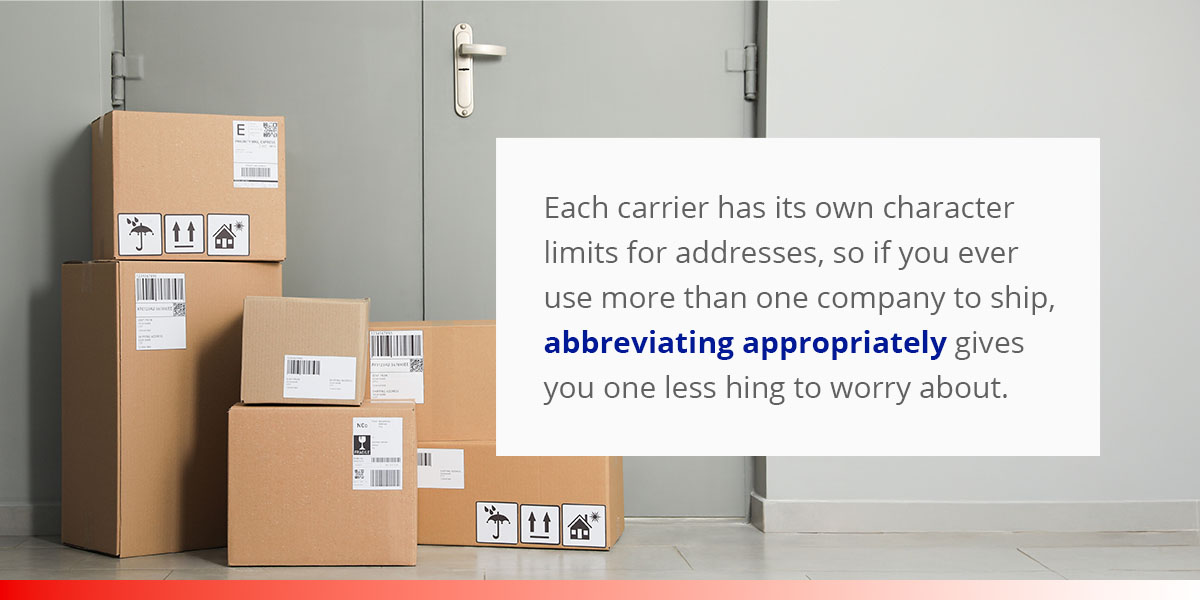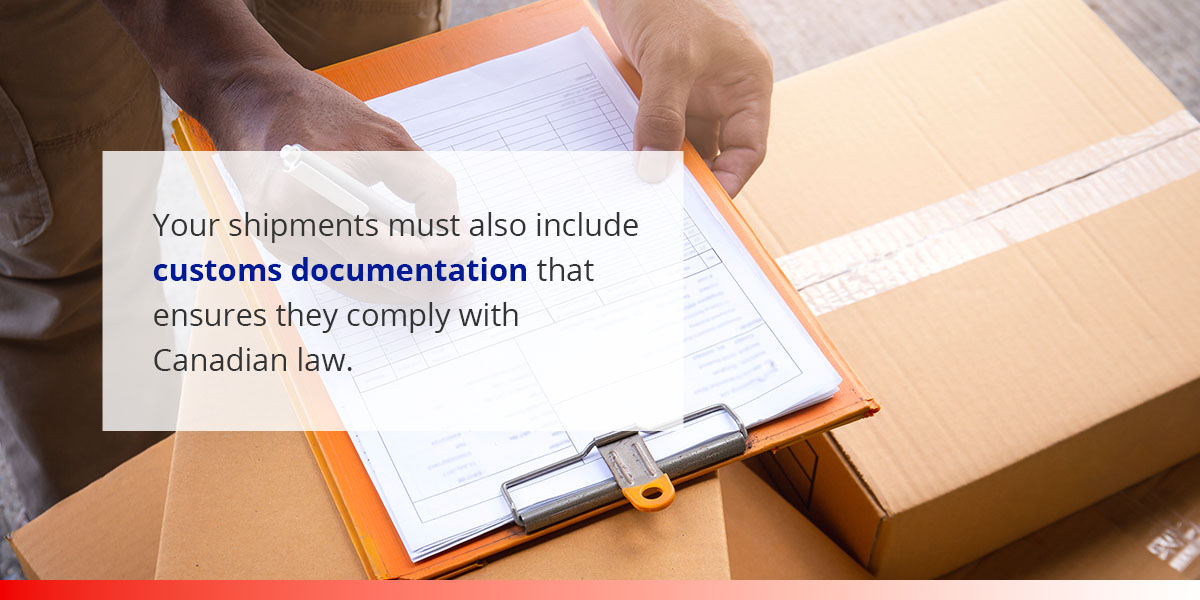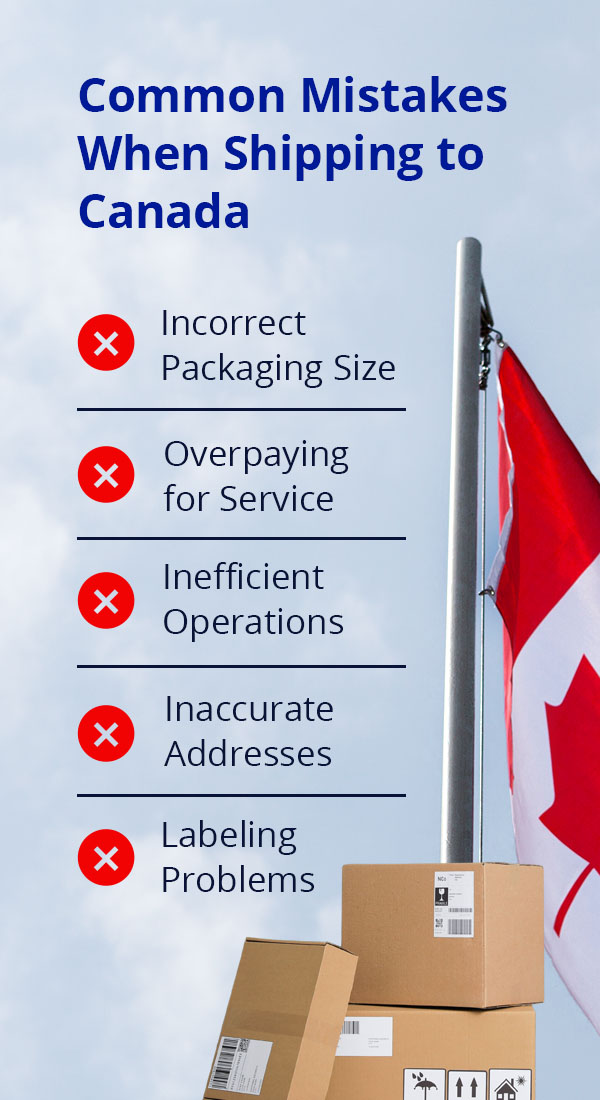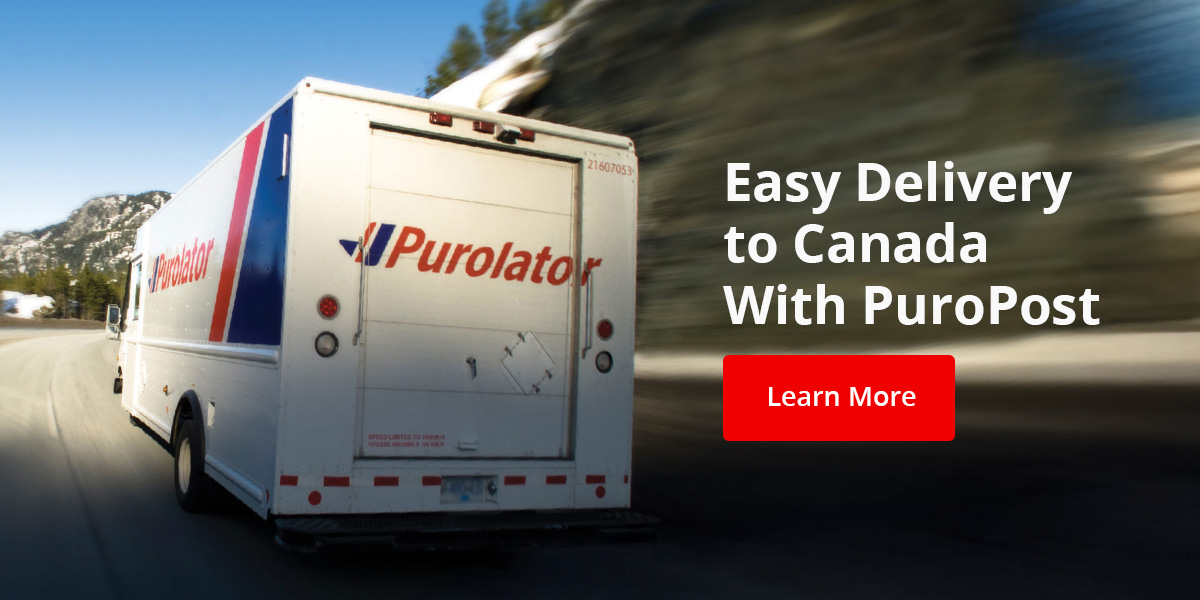Blog
How to Write a Label for a Package Being Shipped to Canada

Updated: February 17, 2025
Many U.S. retailers are realizing the benefits of expanding their presence in Canada and looking forward to the potential rewards. However, shipping from the U.S. to Canada is an opportunity that requires a strategy to avoid costly mistakes. Most of these mistakes are as simple as missing important information on shipping labels and packaging practices that ensure cross-border shipping of products. This guide breaks down how to write a shipping label and address a package to Canada.
Parts of a Canadian Shipping Label
The logistics of Canadian shipping labels can be confusing. You must be familiar with all its parts to print your shipping label correctly. The four essential parts to get right on a Canadian shipping label are the name, the street address, the city, the province or postal code and the country. These fields may seem basic, but getting any of them wrong can result in an issue when a package is delayed or returned due to inaccuracies.
1. Recipient Name
Having the recipient’s first, middle and last name is not always a requirement, but having their full name as listed on their government-issued ID is ideal, no matter what country they’re in. Some customers don’t like giving out their actual information, but sending and receiving international orders under a seemingly fake name can raise flags at customs or even at the post office.
Address verification software often has a feature that allows you to flag orders with billing names that completely differ from the name on the shipping address. Use your best judgment to decide if you should contact the recipient to get an accurate name matching the ID if they need to pick up the item at the customs or post office.
Addresses that contain company names can be added to the label. Be mindful of any character limits on address lines, as you don’t want to have any partial information that may be confusing.
2. The Address
The recipient’s street address is the next section on shipping labels to Canada. The physical address identifies the individual or organization to which the mail and packages are forwarded. The Canadian address includes three main lines — the addressee in the first line, the civic address in the second line and the municipality name, territory or province and postal code in the third line.
Some widely used best practices on how to write a Canadian address are:
- Use uppercase letters.
- Put information like title or floor above the street address.
- Place hyphens between the unit, suite or apartment number and the street number.
- Don’t use the “#” symbol.
- Abbreviate the street type — for example, put “AVE” for Avenue.
- Abbreviate the street direction — for example, put “S.E.” for Southeast.
Following these guidelines as closely as possible is key to a smooth shipping process. It helps avoid any issues related to character limits on labels. Each carrier has its own character limits for addresses, so if you ever use more than one company to ship, abbreviating appropriately gives you one less thing to worry about.
3. City, Postal Code and Province
Omitting the province is a surprisingly common Canadian shipping label problem. Not all countries require the province, but if you leave it off when shipping to Canada, your package will definitely be returned. Here are some best practices when filling in the postal code on packages and mail addressed to Canada:
- Include the city, province and postal address on the same line.
- Add one space between the city and the province and two spaces to separate the province and the postal code.
- Don’t use hyphens to separate the first and last three elements of the postal code — use a space instead.
4. Destination Country
Another essential part of addressing a package to Canada is adding the country at the end. However, it’s more complicated than most people realize. When adding this last component, ensure that:
- “Canada” is bolded.
- “CANADA” is uppercase.
- You write the entire name of the country — don’t abbreviate.
- You double-check your spelling.
- You put it on the final line.
Forgoing any of these steps can invalidate the address and result in a failed delivery, costing you time and customer satisfaction.
5. Product Information
Multiple sections on the label must contain information about the product being shipped, including:
- A detailed description of the contents.
- Item quantity.
- Package weight, which includes the weight of the item being shipped and the box or packaging.
- Item value in U.S. dollars.
- Tariff number (if applicable).
- Country of origin.
- Insured value.
- Insured fee.
- The routing number, which helps determine the best route for shipping.
- The tracking number and bar code, which help track the shipment process in transit.
- Unidirectional or QR code that contains a digital version of the product information.
Accuracy is paramount here, as misrepresenting the item, weight or quantity can get you in trouble with customs or attract unexpected tariffs. The shipping label should also include special instructions for handling the package, such as “This Side Up,” “Flammable” and “Fragile.”
Canada Customs Documents
Products being shipped to Canada are subject to numerous restrictions and prohibitions. Your shipments must also include customs documentation that ensures they comply with Canadian law. These custom documents and labels must all be present for products and freight, with the exception of envelopes weighing less than 473 milliliters (16 ounces), to be cleared through customs and reach the final shipping phase.
The specific customs forms you need vary depending on your shipment type and partner. However, here are some basic international shipping documents for shipping products to Canada.
Bill of Lading (BOL)
A BOL is a legal document that permits the carrier to facilitate the transit of goods on behalf of the consignor. The BOL represents the receipt and shipping label for freight shipments. You can find the BOL on the freight shipper’s website, fill it out, print it and hand it to the pickup driver. It contains all the vital information about the shipping and receiving parties, including:
- Names and complete addresses of shipper and receiver.
- Special account numbers or P.O. used for order tracking between businesses.
- Any special delivery instructions necessary for prompt delivery.
- Shipment date.
- Number of shipping units.
- Types of packaging, such as cartons, skids, drums or pallets.
- When applicable, a note indicating that a commodity is listed as a hazardous material.
- Description of the items being shipped, which should include the manufacturing material and name of the items.
- Freight classification for the shipped items.
- The exact weight of each commodity in the shipment.
- The declared value of the shipped goods.
Canada Customs Invoice (CCI)
This document informs Canadian customs of specific information needed for cross-border shipments. A CCI includes information about how the importer plans to pay the seller and can be used by the exporter to collect payment. Some of the details on the CCI document include:
- Name and address of the vendor.
- Date of direct shipment to Canada.
- Name and address of the consignee.
- Name and address of the purchaser.
- Country of transshipment and country of origin of goods.
- Condition of sale and terms of payment.
- Currency of settlement.
- Number of packages.
The CCI also includes information like quantity and unit price. It is similar to a BOL, and you need two copies — one copy goes with the shipment, while the second is attached to the BOL.
Commercial Invoice
The commercial invoice is more basic than the CCI and contains much of the same information. It proves that the buyer or importer has paid the vendor or exporter. Again, one copy accompanies the shipment, and the other goes with the BOL. For the commercial invoice to be effective, it must include the following information:
- A detailed description of the products being shipped
- The net and gross weight of the package
- The exporter’s and importer’s full name and address
- The unit price, which is listed in the settlement currency
- The date of dispatch
- The terms and conditions of payment and delivery
- The country of the exporter and the manufacturer
- The purchaser’s order number or reference numbers
- Freight charges and insurance
Proof of Delivery (POD)
The POD confirms that the shipment was delivered successfully. It lists that the goods were received as intended and includes the date and time of the delivery. Unlike the BOL, the POD is not a legal document or contract between the shipper and the freight carrier. There are different types of PODs, including:
- A physical POD that’s signed by hand.
- An electronic POD, which is signed using an e-signature or by scanning a code. It may also include specialized signatures such as a Chain of Signatures (COS) or an Adult Signature Required (ASR), depending on the destination province.
- A photo POD that captures a digital image of the package at delivery.
Certificate of Origin
For products produced or substantially manufactured in a United States-Mexico-Canada Agreement (USMCA) member country after July 1, 2020, the certificate of origin is not necessary. The new USMCA allows importers to include nine required data elements and a certification statement without following a prescribed format. These elements include:
- Information about the exporter, importer, certifier and producer.
- Description and Harmonized Tariff System (HTS) classification of products.
- The origin criteria for the goods.
- The specified blanket period if it covers multiple shipments.
- Authorized date and signature.
The USMCA allows the completion, signing and submission of the certificate of origin electronically. The certificate of origin may apply to a single shipment or multiple shipments of identical products within a year.
Common Mistakes When Shipping to Canada
With so many shipping restrictions and paperwork involved in shipping products to Canada, it’s easy to make mistakes that lead to costly delays. While many things can go wrong when shipping to Canada, some particularly common mistakes are:
Incorrect Packaging Size
Choosing the right packaging size helps minimize the risk of product damage during shipment by providing enhanced cushioning and protection. Additionally, an inefficient packaging design wastes valuable business resources, and the excess material may increase material costs. Customized packaging solutions are the best option because they are optimized for your needs.
Your packaging should factor in the size and weight restrictions to avoid extra charges, the need for repackaging and package rejection at customs. You must consider even weight distribution to ensure smooth transit and avoid uneven load issues.
Overpaying for Service
Shipping costs may accrue quickly, especially when you’re not keen on the conversion rates from cart to checkout. Every shipment should be able to cover the corresponding shipping costs and bring a fair return on investment.
To avoid overpaying for your shipments, work with reliable shipping companies that provide fair rates and multiple options, including free, economy, expedited or overnight shipping. You can save shipping costs by shipping a high volume of products and custom packaging to optimize the weight.
Inefficient Operations
Many international shipping companies waste resources because of inefficient operations. Partnering with professional third-party logistics providers helps avoid many issues and inefficiencies associated with the shipping and delivery process. Thanks to their knowledge, expertise and advanced equipment, they streamline shipping by shortening delivery windows.
Automated shipping solutions allow you to manage tracking, reporting and billing as efficiently as possible, which is crucial to your customers’ satisfaction. Professional shipping companies have experience with customs regulations and documentation, helping you avoid possible penalties and delays.
Inaccurate Addresses
Incorrectly typed addresses are a big issue with shipping labels to Canada. Getting the address wrong, even by a single letter or number, results in unsuccessful delivery or extended delays. Carriers may be unable to complete the delivery, resulting in the package being returned to you and causing extra expenses and unsatisfied customers.
An address verification system checks for customer information accuracy before you complete orders, ensuring you process the orders correctly the first time. You can eliminate the issue of creating invalid shipping labels to Canada.
Labeling Problems
Gone are the days of hand-writing shipping labels. Today, they are printed from your computer in seconds after you fill in the required information, and as long as you fill in the correct fields, your products can be shipped immediately.
However, even with the digital production of labels, some issues can still occur, especially with tracking the shipment. For instance, the barcode on your packaging label must be scanned at various points during shipping and delivery. If the barcode can’t be automatically scanned, you can incur extra fees and void any service delivery guarantees you may have in place.
Another common problem is placing the label in the wrong place or affixing it poorly, which can affect tracking and stall your deliveries. When learning how to label packages being shipped to Canada, ensure that the label:
- Is attached to the largest side of the box so the automatic scanners can easily see the barcode.
- Isn’t obscured by packing tape or folded along the edge of the package.
- Can be placed into a plastic pouch to protect it from the elements.
- Has a clear, crisp barcode free of smudges.
- Is not too large or too small.
- Is attached using a strong enough adhesive.
- Is oriented correctly.
- Is not embedded on an uneven surface, as this can cause wrinkling and creasing.
- Is affixed in a completely flat position to avoid wrinkles in the barcode.
You may be able to automate the shipping label production process with tools offered through various carriers — this helps reduce the work required to prepare your shipping labels and your manifests.
Ensuring Product Labeling Compliance
It’s not just your shipping label that has to be correct in order to ship to Canada successfully. For your products to make it through customs, they must adhere to the Consumer Packaging and Labelling Act. The relevant sections are as follows:
- Section 6: This forbids a dealer from importing or selling any prepackaged product that doesn’t meet the packaging requirements listed in the following regulations.
- Subsection 4-1: Dealers cannot sell, import or advertise a prepackaged product unless the net quantity has been declared.
- Subsection 4-2: The net quantity declaration must be visible on the product’s main display panel. It must be clear, prominent and legible, creating distinct visual contrast to the other information and representations on the label. Any prepackaged product with a net quantity declaration must also convey an account of the product’s identity. It can be its function, generic name or common name.
- Subsection 7-1: Dealers cannot sell, import or advertise products with labels containing misleading or false representations about a product.
- Subsection 7-2: Packages cannot have words, depictions, symbols, expressions, figures, descriptions or illustrations that could be considered misleading or false representations.
- Subsection 7-3: Packages cannot have less product than the declared quantity indicates within certain prescribed tolerances.
- Subsection 9-1: Dealers cannot sell, import or advertise products in any container that is made, filled or labeled in a way that can mislead consumers about the quantity or quality of the product being sold.
Easy Delivery to Canada With PuroPost
Shipping to Canada should be quick and easy. With PuroPost, you can enjoy seamless and efficient cross-border services for U.S. businesses shipping products to Canada. Our two-to-eight-day delivery policy ensures your customers receive cost-effective deliveries within the deadlines.
At Purolator International, we also generate your shipping labels quickly and accurately so your products get where they need to be without inconvenience. We offer regular pickups across the U.S. and final package delivery through Canada Post.
With over 16 million addresses in our scope, you can confidently ship to parcel lockers, P.O. boxes, community mailboxes and out-of-the-way locations. To learn more about PuroPost and the variety of services Purolator International offers, call us at 1.888.511.4811 to speak with a knowledgeable representative.



